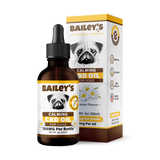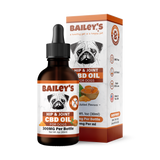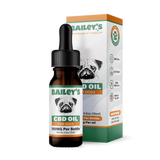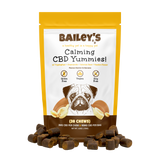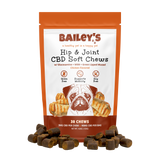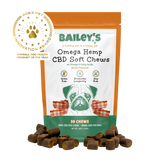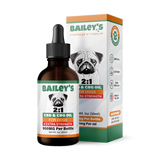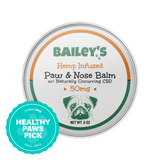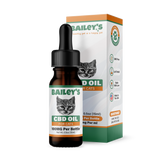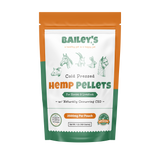Sourdough Bread and Dogs: Dietary Caution
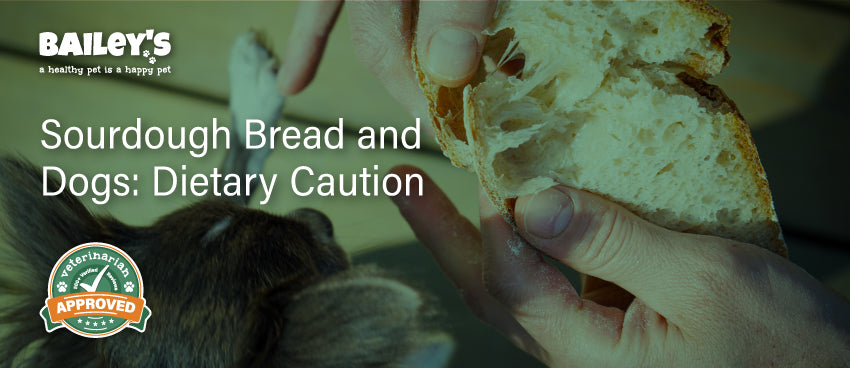
Sourdough bread is a beloved staple in many households for its tangy flavor and unique texture. Dogs, on the other hand, have their own dietary needs that require careful consideration. While sharing a small piece of bread with your furry friend may seem harmless, it's important to understand the potential risks and take necessary precautions.

We will delve into the world of sourdough bread and dogs today with our friendly experts from Bailey’s CBD , discussing the process of making sourdough bread, the nutritional components of sourdough bread, dogs' dietary needs, the risks associated with sourdough bread for dogs, how to prevent accidental ingestion and alternative snack options for dogs.
Table of Contents
1. Understanding Sourdough Bread
Sourdough bread is a type of bread made by the fermentation of dough using naturally occurring lactobacilli and yeast. This fermentation process gives sourdough bread its distinctive tangy flavor and chewy texture that many people enjoy. The process of making sourdough bread involves a starter, which is a mixture of flour and water that is left to ferment and develop wild yeast and lactobacilli cultures. These cultures then leaven the bread dough, resulting in the desired texture and taste.
1.1 The Process of Making Sourdough Bread
To make sourdough bread, a starter is created by combining flour and water. This mixture is then left at room temperature for several days, during which time it ferments and develops a vibrant community of natural yeast and lactobacilli. The wild yeast in the starter consumes the carbohydrates in the flour and produces carbon dioxide gas, which causes the dough to rise. The lactobacilli, on the other hand, produce lactic acid, which gives the bread its tangy flavor. This symbiotic relationship between the yeast and lactobacilli is what makes sourdough bread unique.
Once the starter is ready, it is mixed with additional flour, water, and sometimes salt to create the bread dough. The dough is then left to rise for a while, allowing the fermentation process to occur. During this time, the wild yeast and lactobacilli continue to feed on the carbohydrates in the dough, producing more carbon dioxide gas and lactic acid. This process gives the bread its airy texture and tangy taste.
After the dough has risen, it is shaped into loaves or other desired shapes. The surface of the dough is often scored with a sharp knife or razor blade, which helps control the expansion of the dough during baking. This scoring also creates a beautiful pattern on the crust of the bread. The shaped dough is then left to rise again, allowing it to further develop its flavor and texture.
Finally, the dough is baked at high temperatures, typically around 450°F (230°C), to create a crusty loaf of sourdough bread. The high heat causes the moisture in the dough to evaporate rapidly, creating steam. This steam helps to create a crisp and golden crust while the inside of the bread remains soft and chewy. The result is a loaf of sourdough bread with a beautiful crust, a tangy flavor, and an airy texture.
1.2 Nutritional Components of Sourdough Bread
Sourdough bread offers a range of nutritional components. It is a good source of carbohydrates, which provide energy. The fermentation process in sourdough bread also breaks down complex carbohydrates into simpler forms, making them easier to digest. This can be beneficial for individuals with digestive sensitivities or those looking to manage their blood sugar levels.
In addition to carbohydrates, sourdough bread contains dietary fiber, which supports healthy digestion. The fermentation process increases the fiber content of the bread, making it more filling and promoting a feeling of satiety. This can be particularly beneficial for individuals looking to manage their weight or improve their overall gut health.
Furthermore, sourdough bread provides minerals such as iron, magnesium, and selenium. These minerals are essential for various bodily functions, including the production of red blood cells, the maintenance of bone health, and the support of the immune system. Sourdough bread is also a source of B vitamins like thiamine and folate, which play important roles in energy metabolism and the synthesis of DNA and red blood cells.
However, it's important to note that the specific nutritional content of sourdough bread can vary depending on the recipe and fermentation process used. Factors such as the type of flour used, the duration of fermentation, and the temperature at which the bread is baked can all influence the nutritional profile of the final product. Nevertheless, sourdough bread, with its unique flavor, texture, and nutritional benefits, remains a popular choice among bread enthusiasts.
2. Dogs and Their Dietary Needs
Dogs have specific dietary needs that differ from humans. They require a balanced diet that includes essential nutrients to support their overall health and well-being. Dogs need a combination of proteins, fats, carbohydrates, vitamins, and minerals to thrive. A high-quality commercial dog food that is formulated to meet these nutritional requirements is typically recommended. It's always best to consult with a veterinarian to determine the specific dietary and supplementary needs of your dog.
When it comes to proteins, dogs require a sufficient amount to provide the necessary building blocks for muscle development and repair. Proteins are made up of amino acids, which are essential for the growth and maintenance of tissues in the body. High-quality sources of protein for dogs include meat, fish, and poultry. These animal-based proteins are highly digestible and provide all the essential amino acids that dogs need.
Fats are another important component of a dog's diet. They are a concentrated source of energy and are necessary for the absorption of fat-soluble vitamins. Fats also play a crucial role in maintaining healthy skin and coat. Omega-3 and omega-6 fatty acids, found in fish oil and certain plant oils, are particularly beneficial for dogs. These fatty acids have anti-inflammatory properties and can help improve skin health and reduce itching and inflammation.
Carbohydrates, such as those found in grains and vegetables, provide dogs with energy and fiber for healthy digestion. While dogs are primarily carnivorous, they can still benefit from the inclusion of carbohydrates in their diet. However, it's important to choose carbohydrates that are easily digestible and low in simple sugars. Whole grains like brown rice and oats, as well as vegetables like sweet potatoes and peas, are good sources of carbohydrates for dogs.
2.1 Essential Nutrients for Dogs
In addition to proteins, fats, and carbohydrates, dogs also require a variety of vitamins and minerals to maintain optimal health. Vitamin A, for example, is essential for healthy vision, immune function, and cell growth. Dogs can obtain vitamin A from sources like liver, carrots, and sweet potatoes. Vitamin D is important for calcium absorption and bone health. It can be synthesized by the body when dogs are exposed to sunlight, but it can also be found in fatty fish and egg yolks.
Calcium and phosphorus are two minerals that are crucial for the development and maintenance of strong bones and teeth in dogs. These minerals can be obtained from sources like dairy products, bone meal, and certain vegetables. However, it's important to ensure that the calcium-to-phosphorus ratio in a dog's diet is balanced, as an imbalance can lead to skeletal abnormalities.
2.2 Foods That Are Harmful to Dogs
While certain human foods, such as certain fruits and vegetables, can be safely incorporated into a dog's diet, others should be completely avoided. Some common foods that can be harmful to dogs include chocolate, caffeine, grapes and raisins, onions and garlic, and foods high in salt or sugar. These foods can cause a range of issues, including toxicity, digestive upset, and in severe cases, organ damage.
Chocolate contains theobromine, a compound that dogs cannot metabolize effectively. Even small amounts of chocolate can cause symptoms like vomiting, diarrhea, increased heart rate, and in severe cases, seizures or even death. Similarly, caffeine can have a stimulating effect on a dog's central nervous system and can lead to symptoms like restlessness, rapid breathing, and muscle tremors.
Grapes and raisins are toxic to dogs and can cause kidney failure. The exact mechanism behind this toxicity is not fully understood, but even small amounts can be dangerous. Onions and garlic, whether raw, cooked, or in powdered form, contain compounds that can damage a dog's red blood cells and lead to anemia. Foods high in salt or sugar can also be harmful to dogs, as they can disrupt the balance of electrolytes in the body and contribute to conditions like dehydration and obesity.
It's important to be mindful of what you feed your dog and keep potentially harmful foods out of their reach. If you suspect that your dog has ingested something toxic, it's crucial to seek veterinary attention immediately. Prompt treatment can make a significant difference in the outcome and prevent further complications.

3. The Risks of Sourdough Bread for Dogs
While sourdough bread may be a delicious treat for humans, it can pose potential risks to dogs. It's essential to understand these risks to protect the health of your furry companion.
3.1 Immediate Health Risks
Sourdough bread can cause immediate health issues for dogs. The bread itself can be difficult for dogs to digest, potentially leading to gastrointestinal upset, including vomiting and diarrhea. Additionally, the fermentation process used in sourdough bread can produce alcohol as a byproduct. Alcohol is toxic to dogs and can lead to symptoms such as breathing difficulties, coordination issues, and even alcohol poisoning. These immediate health risks make it important to prevent dogs from consuming sourdough bread.
3.2 Long-Term Health Risks
Long-term ingestion of sourdough bread can also have adverse effects on dogs. The high carbohydrate content in bread can contribute to weight gain and obesity in dogs, which can lead to various health problems, including joint issues, diabetes, and heart disease. Furthermore, the presence of gluten in sourdough bread can cause gluten intolerance or allergies in some dogs. These long-term health risks highlight the importance of being cautious about feeding sourdough bread to dogs.
4. How to Prevent Accidental Ingestion
Preventing accidental ingestion of sourdough bread is crucial to ensuring your dog's well-being. By taking a few simple precautions, you can minimize the chances of your dog consuming this potentially harmful food.
4.1 Safe Storage of Sourdough Bread
When storing sourdough bread, it's important to keep it out of reach of your dog. Store bread in a sealed container or in a bread box that cannot be easily opened by your pup. Avoid leaving bread unattended on countertops or tables where dogs may easily access it. By storing sourdough bread safely, you can minimize the temptation and risk for your dog to consume it.
4.2 Training Your Dog to Avoid Certain Foods
Training your dog to avoid certain foods, including sourdough bread, can be a helpful preventive measure. Teaching your dog basic commands, such as "leave it" or "drop it," can be useful in situations where your dog may be tempted by food. Positive reinforcement training methods, such as rewarding your dog with treats or praise for making the right choices, can be effective in reinforcing desired behaviors. By training your dog to avoid certain foods, you can further reduce the risk of accidental ingestion.
5. Alternatives to Sourdough Bread for Dogs
If you're looking for alternative options to satisfy your dog's snack cravings, there are several dog-friendly bread options and other safe snack alternatives available.
5.1 Dog-Friendly Bread Options
There are bread options specifically formulated for dogs that can be a safer alternative to sourdough bread. Dog-friendly breads are typically made with ingredients that are safe and beneficial for dogs. These breads can provide a tasty and nutritious snack option for your furry friend. Always ensure that any dog-friendly bread you offer is free of harmful ingredients and fits within your dog's overall balanced diet.
5.2 Other Safe Snack Alternatives for Dogs
Beyond bread, there are plenty of safe and healthy snack alternatives for dogs. Fruits, such as sliced apples or bananas, can make a tasty and nutritious treat. Vegetables, such as baby carrots or green beans, are also great options. Just be sure to avoid giving your dog any foods that are toxic to them, and be mindful of portion sizes to prevent overfeeding.

